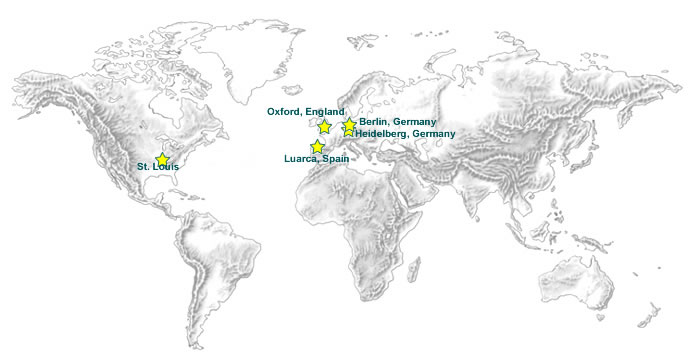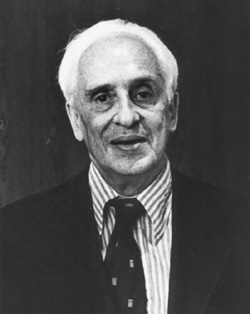Severo Ochoa (1905-1993)
Severo Ochoa’s long and distinguished career as a biochemist parallels the development of the field over time and geography. His work and publications spanned seven decades and two continents. Ochoa worked in the cities where the scientific activity was at its greatest intensity: Berlin, Heidelberg, Oxford, St. Louis and New York. He held over 30 honorary doctorates, published well over 200 scientific papers, and was awarded many prizes. In 1959 Ochoa and Arthur Kornberg were awarded the Nobel Prize in Physiology or Medicine “for their discoveries of the mechanisms in the biological synthesis of ribonucleic and deoxyribonucleic acids.”
Ochoa’s research dealt mainly with enzymatic processes in biological oxidation and synthesis and the transfer of energy. It contributed greatly to the knowledge of the basic steps in the metabolism of carbohydrates and fatty acids, the utilization of carbon dioxide, and the biosynthesis of nucleic acids. His work in 1955 on polynucleotide phosphorylase (PNPase), an enzyme that catalyzes the polymerization of polyribonucleotides, led to the Nobel Prize. His contribution to deciphering the genetic code established him as a scientist at the cutting edge of molecular biology during the 1960s.
Severo Ochoa was born in Luarca, Spain in 1905. Interested in biology and stimulated by the work of the great Spanish neurologist Santiago Ramón y Cajal, Ochoa entered the Medical School of the University of Madrid. After his graduation in 1929 Ochoa went to work under Otto Meyerhof at the Kaiser Wilhelm Institut für Medizinische Forschung (first in Berlin and then in Heidelberg) where he researched the biochemistry and physiology of muscle. Ochoa credited Meyerhof as “the teacher who most contributed towards my formation, and the most influential in directing my life’s work.”
Ochoa returned to Spain in 1931 and began to teach physiology and biochemistry at the University of Madrid. The following year he went to London to extend his training in enzymology with H. W. Dudley at the National Institute for Medical Research. In 1934 Ochoa was back in Madrid, teaching at the university and further investigating the chemistry of muscle. His work was interrupted by the Spanish Civil War in 1936, however. Ochoa went to Heidelberg as a guest researcher, then to England where he worked at the Plymouth Marine Biological Laboratory and at Oxford University. In 1941 Ochoa came to the United States, joining the faculty of the Washington University School of Medicine as instructor and research associate in Pharmacology and working in the laboratory of Carl and Gerty Cori on the problems of enzymology. During his year and a half in St. Louis, Ochoa was imbued with the importance and techniques of isolating and characterizing enzymes.
In 1942 Ochoa was appointed research associate in Medicine at the New York University School of Medicine. He subsequently became assistant professor of Biochemistry in 1945, professor of Pharmacology in 1946, professor of Biochemistry and chairman of the Department of Biochemistry in 1954. In 1956 Ochoa became a U.S. citizen. After his retirement from NYU in 1974 Ochoa accepted an offer to join the Roche Institute of Molecular Biology in New Jersey. There he continued his work on protein synthesis and the replication of RNA viruses. Ochoa retired in 1985 and returned to Spain; he died in Madrid in 1993.
Sources:
Grisolia, Santiago. “The Tenth Anniversary of the Death of Severo Ochoa.” IUBMB Life. 56, no. 2 (2004): 55-57.
International Symposium on Enzymatic Mechanisms in Biosynthesis and Cell Function, Barcelona and Madrid, 1975. Reflections on Biochemistry: In Honour of Severo Ochoa. Edited by Arthur Kornberg et al. Oxford, England: Pergamon Press, 1976.
Nobel Lectures, Physiology or Medicine 1942-1962. Amsterdam: Elsevier Publishing Company, 1964.
Riedman, Sarah R. and Elton T. Gustafson. Portraits of Nobel Laureates in Medicine and Physiology. London: Abelard-Schuman, 1963.
Santesmases, Maria Jesus. “Severo Ochoa (1905-1993): the changing world of biochemistry.” Trends in Biomedical Sciences. 26, no. 2 (2001): 140-42.

Related Resources:
Back to Biographies

